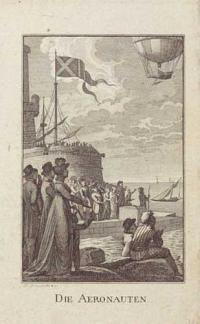
Die Aeronauten.
J: Blaschke sc.
[n.d., c.1840].
Engraving, sheet 135 x 85mm (5¼ x 3¼"). Cut to plate on threee sides.
A german print depicting a hot air ballon manned by a single person flies above a sea port watched by huge crowds. A unidentified swallow tailed flag waves in the wind above a battlement and a ships mast can be seen behind.
[Ref: 56937] £130.00
(£156.00 incl.VAT)

The Eumenides of Aeschylus as Performed by Members of the University at the Theatre Royal Cambridge December 1885..
Drawn and Etched by Robert Farren.
Cambridge: Macmillan And Bowes, 1884.
Seven etchings. Each c. 180 x 225mm (7 x 9"), on thick paper with wide margins. With a duplicate plate on regular paper and a plate from one of Farren's earlier series.
The illustrated titlepage and six plates illustrating the staging of 'The Eumenides', the third and final play in the 'Oresteia', the story of Orestes, first performed in 458BC. The plates are titled in Greek letters. Although the illustrations are complete a printed cast list is lacking. Robert Farren (1832-1910) was a topographical etcher and illustrator, who owned a print business in Cambridge, before moving to Scarborough in 1889 for his health.
[Ref: 44549] £160.00
(£192.00 incl.VAT)
view all images for this item
![[Life of Aesop: Aesop convicting his fellow servants of having eaten the figs.]](img-thumbnail/jpegs/48708.jpg)
[Life of Aesop: Aesop convicting his fellow servants of having eaten the figs.] [So thrive false witnesses...]
[Etched by Thomas Dudley after Francis Barlow.]
[Amsterdam: Etiènne Roger, 1714.]
Etching. Sheet 205 x 165mm (8 x 6½") Trimmed within plate, mounted on album paper.
Aesop, having beeen accused of eating his master's figs, has vomited to show he had eaten nothing, then insists his accusers do the same, proving their guilt. Plate 1 of thirty-one illustrations added to the second edition of Barlow's "Æsop's Fables, With His Life" (1687), to illustrate the translation of Planudes's Life of Aesop, which was unillustrated in the first edition of 1666. This example comes from an Amsterdam edition, 'Les Fables d'Esope', with the printing plate trimmed down. All of the plates were designed by Barlow: they were etched c.1678-9, only five by Barlow; the rest, including this one, by Thomas Dudley. Originally the plate extended down with a title verse (possibly written by Aphra Behn, who wrote new verses for the fables), but for this non-English edition the verse was trimmed off and new borders engraved. Little is known of Dudley: on one plate of this series he signed himself as a student of Wenceslaus Hollar; and in 1679 he went to Lisbon, where he is known to have made further prints, and he is not supposed to have returned to England thereafter. He etched some portraits but these prints after Barlow are his most important work. BM: 1871,0812.235, described as a proof state.
[Ref: 48708] £95.00
(£114.00 incl.VAT)
![[Life of Aesop: Aesop resolving the gardener's problem.]](img-thumbnail/jpegs/48712.jpg)
[Life of Aesop: Aesop resolving the gardener's problem.] [No more you learned fops...]
Tho: Dudley fecit [after Francis Barlow.]
[Amsterdam: Etiènne Roger, 1714.]
Proof etching. Sheet 205 x 165mm (8 x 6½") Trimmed within plate, mounted on album paper.
A gardener asks of Xanthus why his cultivated herbs did not grow as well as wild ones. Aesop replied that Mother Nature regarded them as step-children rather than her own. Plate 7 of thirty-one illustrations added to the second edition of Barlow's "Æsop's Fables, With His Life" (1687), to illustrate the translation of Planudes's Life of Aesop, which was unillustrated in the first edition of 1666. This example comes from an Amsterdam edition, 'Les Fables d'Esope', with the printing plate trimmed down. All of the plates were designed by Barlow: they were etched c.1678-9, only five by Barlow; the rest, including this one, by Thomas Dudley. Originally the plate extended down with a title verse (possibly written by Aphra Behn, who wrote new verses for the fables), but for this non-English edition the verse was trimmed off and new borders engraved. Little is known of Dudley: on one plate of this series he signed himself as a student of Wenceslaus Hollar; and in 1679 he went to Lisbon, where he is known to have made further prints, and he is not supposed to have returned to England thereafter. He etched some portraits but these prints after Barlow are his most important work. BM: 1871,0812.241, described as a proof state.
[Ref: 48712] £110.00
(£132.00 incl.VAT)
![[Life of Aesop: Aesop ordered by Xanthus to take a dish to her that loves him best.]](img-thumbnail/jpegs/48699.jpg)
[Life of Aesop: Aesop ordered by Xanthus to take a dish to her that loves him best.] [A Wife, or Dog, as certaine reasons prove...]
Tho: Dudley fecit 1678 [after Francis Barlow].
[Amsterdam: Etiènne Roger, 1714.]
Proof etching. Sheet 205 x 165mm (8 x 6½") Trimmed within plate, mounted on album paper.
Xanthus, Aesop's master, hands a dish of meat to Aesop, expecting him to give it to his wife. However Aesop gives in to a dog, seen in the background. Top right are musicians in a gallery Plate 8 of thirty-one illustrations added to the second edition of Barlow's "Æsop's Fables, With His Life", to illustrate the translation of Planudes's Life of Aesop, which was unillustrated in the first edition of 1666. This example comes from an Amsterdam edition, 'Les Fables d'Esope', with the printing plate trimmed down. All of the plates were designed by Barlow: they were etched c.1678-9, only five by Barlow; the rest, including this one, by Thomas Dudley. Originally the plate extended down with a title verse (possibly written by Aphra Behn, who wrote new verses for the fables), but for this non-English edition the verse was trimmed off and new borders engraved. Little is known of Dudley: on one plate of this series he signed himself as a student of Wenceslaus Hollar; and in 1679 he went to Lisbon, where he is known to have made further prints, and he is not supposed to have returned to England thereafter. He etched some portraits but these prints after Barlow are his most important work. BM: 1871,0812.243, described as a proof state.
[Ref: 48699] £95.00
(£114.00 incl.VAT)
![[Life of Aesop: Aesop serving tongues.]](img-thumbnail/jpegs/48715.jpg)
[Life of Aesop: Aesop serving tongues.] [The maryed men afronted at the jest...]
[Etched by Thomas Dudley after Francis Barlow.]
[Amsterdam: Etiènne Roger, 1714.]
Proof etching. Sheet 205 x 165mm (8 x 6½") Trimmed within plate, mounted on album paper.
Aesop, ordered to serve a dinner of the best, serves up tongues at every course to Xanthus and his guests. When confronted, Aesop replies ''What excels the tongue? It is the great channel of learning and philosophy''. Plate 10 of thirty-one illustrations added to the second edition of Barlow's "Æsop's Fables, With His Life" (1687), to illustrate the translation of Planudes's Life of Aesop, which was unillustrated in the first edition of 1666. This example comes from an Amsterdam edition, 'Les Fables d'Esope', with the printing plate trimmed down. All of the plates were designed by Barlow: they were etched c.1678-9, only five by Barlow; the rest, including this one, by Thomas Dudley. Originally the plate extended down with a title verse (possibly written by Aphra Behn, who wrote new verses for the fables), but for this non-English edition the verse was trimmed off and new borders engraved. Little is known of Dudley: on one plate of this series he signed himself as a student of Wenceslaus Hollar; and in 1679 he went to Lisbon, where he is known to have made further prints, and he is not supposed to have returned to England thereafter. He etched some portraits but these prints after Barlow are his most important work. BM: 1871,0812.252, described as a proof state.
[Ref: 48715] £95.00
(£114.00 incl.VAT)
![[Life of Aesop: Aesop taken to prison.]](img-thumbnail/jpegs/48710.jpg)
[Life of Aesop: Aesop taken to prison.] [How vaine are mens designes...]
Tho: Dudley fecit [after Francis Barlow.]
[Amsterdam: Etiènne Roger, 1714.]
Proof etching. Sheet 205 x 165mm (8 x 6½") Trimmed within plate, mounted on album paper.
Having found treasure for Xanthus, Xanthus still orders Aesop to be imprisoned. Aesop complains of the bad faith and is released. Plate 14 of thirty-one illustrations added to the second edition of Barlow's "Æsop's Fables, With His Life" (1687), to illustrate the translation of Planudes's Life of Aesop, which was unillustrated in the first edition of 1666. This example comes from an Amsterdam edition, 'Les Fables d'Esope', with the printing plate trimmed down. All of the plates were designed by Barlow: they were etched c.1678-9, only five by Barlow; the rest, including this one, by Thomas Dudley. Originally the plate extended down with a title verse (possibly written by Aphra Behn, who wrote new verses for the fables), but for this non-English edition the verse was trimmed off and new borders engraved. Little is known of Dudley: on one plate of this series he signed himself as a student of Wenceslaus Hollar; and in 1679 he went to Lisbon, where he is known to have made further prints, and he is not supposed to have returned to England thereafter. He etched some portraits but these prints after Barlow are his most important work. BM: 1871,0812.247, described as a proof state.
[Ref: 48710] £95.00
(£114.00 incl.VAT)
![[Life of Aesop: Beaten by Xanthus.] [Philosophers like Fortune-tellers thrive,](img-thumbnail/jpegs/48698.jpg)
[Life of Aesop: Beaten by Xanthus.] [Philosophers like Fortune-tellers thrive, / Those by false notions, these false flateries live, / And those as oft true vertue do mistake, / As these false auguries, and predictions make.]
[Etched by Thomas Dudley after Francis Barlow.]
[Amsterdam: Etiènne Roger, 1714.]
Proof etching. Sheet 200 x 165mm (8 x 6½"). Trimmed within plate, mounted on album paper.
Aesop as a slave on Samos, being beaten by his owner Xanthus for saying he had seen two crows, when only one was in sight. Plate 16 of thirty-one illustrations added to the second edition of Barlow's "Æsop's Fables, With His Life", to illustrate the translation of Planudes's Life of Aesop, which was unillustrated in the first edition of 1666. This example comes from an Amsterdam edition, 'Les Fables d'Esope', with the printing plate trimmed down. All of the plates were designed by Barlow: they were etched c.1678-9, only five by Barlow; the rest, including this one, by Thomas Dudley. Originally the plate extended down with a title verse (possibly written by Aphra Behn, who wrote new verses for the fables), but for this non-English edition the verse was trimmed off and new borders engraved. Little is known of Dudley: on one plate of this series he signed himself as a student of Wenceslaus Hollar; and in 1679 he went to Lisbon, where he is known to have made further prints, and he is not supposed to have returned to England thereafter. He etched some portraits but these prints after Barlow are his most important work. BM: 1871,0812.249, described as a proof state.
[Ref: 48698] £95.00
(£114.00 incl.VAT)
![[Life of Aesop: Aesop interpreting an inscription on a tomb, thereby discovering a treasure.]](img-thumbnail/jpegs/48704.jpg)
[Life of Aesop: Aesop interpreting an inscription on a tomb, thereby discovering a treasure.] [How poore is man whom sordid interest sways...]
Tho: Dudley fecit [after Francis Barlow.]
[Amsterdam: Etiènne Roger, 1714.]
Proof etching. Sheet 205 x 165mm (8 x 6½") Trimmed within plate, mounted on album paper.
Aesop agrees to decypher an inscription and find the treasure in return for his freedom. After he digs it up, Xanthus reneges, but Aesop tricks him into giving Aesop half the trove. Plate 19 of thirty-one illustrations added to the second edition of Barlow's "Æsop's Fables, With His Life", to illustrate the translation of Planudes's Life of Aesop, which was unillustrated in the first edition of 1666. This example comes from an Amsterdam edition, 'Les Fables d'Esope', with the printing plate trimmed down. All of the plates were designed by Barlow: they were etched c.1678-9, only five by Barlow; the rest, including this one, by Thomas Dudley. Originally the plate extended down with a title verse (possibly written by Aphra Behn, who wrote new verses for the fables), but for this non-English edition the verse was trimmed off and new borders engraved. Little is known of Dudley: on one plate of this series he signed himself as a student of Wenceslaus Hollar; and in 1679 he went to Lisbon, where he is known to have made further prints, and he is not supposed to have returned to England thereafter. He etched some portraits but these prints after Barlow are his most important work. BM: 1871,0812.250, described as a proof state.
[Ref: 48704] £95.00
(£114.00 incl.VAT)
Unfortunately this item is either sold or reserved. If you are interested in similar items and cannot find what you're looking for on our website, please consider filling in our interests form. If you register, we can also send you items that match your interests when the website is updated.
![[Life of Aesop: Aesop interpreting to the Samians the portent of the eagle and the public ring.]](img-thumbnail/jpegs/48709.jpg)
[Life of Aesop: Aesop interpreting to the Samians the portent of the eagle and the public ring.] [In vaine the learned do their knowledge boast...]
Tho: Dudley fecit [after Francis Barlow.]
[Amsterdam: Etiènne Roger, 1714.]
Proof etching. Sheet 205 x 165mm (8 x 6½") Trimmed within plate, mounted on album paper.
Aesop agrees to decypher a portent and, in doing so, forces his master Xanthus to give him his freedom. Plate 20 of thirty-one illustrations added to the second edition of Barlow's "Æsop's Fables, With His Life" (1687), to illustrate the translation of Planudes's Life of Aesop, which was unillustrated in the first edition of 1666. This example comes from an Amsterdam edition, 'Les Fables d'Esope', with the printing plate trimmed down. All of the plates were designed by Barlow: they were etched c.1678-9, only five by Barlow; the rest, including this one, by Thomas Dudley. Originally the plate extended down with a title verse (possibly written by Aphra Behn, who wrote new verses for the fables), but for this non-English edition the verse was trimmed off and new borders engraved. Little is known of Dudley: on one plate of this series he signed himself as a student of Wenceslaus Hollar; and in 1679 he went to Lisbon, where he is known to have made further prints, and he is not supposed to have returned to England thereafter. He etched some portraits but these prints after Barlow are his most important work. BM: 1871,0812.251, described as a proof state.
[Ref: 48709] £95.00
(£114.00 incl.VAT)
Unfortunately this item is either sold or reserved. If you are interested in similar items and cannot find what you're looking for on our website, please consider filling in our interests form. If you register, we can also send you items that match your interests when the website is updated.
![[Life of Aesop: Aesop kneeling before king Croesus.]](img-thumbnail/jpegs/48714.jpg)
[Life of Aesop: Aesop kneeling before king Croesus.] [Of all the graces, Heaven in man designd...]
[Etched by Thomas Dudley after Francis Barlow.]
[Amsterdam: Etiènne Roger, 1714.]
Proof etching. Sheet 205 x 165mm (8 x 6½") Trimmed within plate, mounted on album paper.
Aesop negotiates with Croesus to prevent war between Lydia and Samos. Plate 21 of thirty-one illustrations added to the second edition of Barlow's "Æsop's Fables, With His Life" (1687), to illustrate the translation of Planudes's Life of Aesop, which was unillustrated in the first edition of 1666. This example comes from an Amsterdam edition, 'Les Fables d'Esope', with the printing plate trimmed down. All of the plates were designed by Barlow: they were etched c.1678-9, only five by Barlow; the rest, including this one, by Thomas Dudley. Originally the plate extended down with a title verse (possibly written by Aphra Behn, who wrote new verses for the fables), but for this non-English edition the verse was trimmed off and new borders engraved. Little is known of Dudley: on one plate of this series he signed himself as a student of Wenceslaus Hollar; and in 1679 he went to Lisbon, where he is known to have made further prints, and he is not supposed to have returned to England thereafter. He etched some portraits but these prints after Barlow are his most important work. BM: 1871,0812.252, described as a proof state.
[Ref: 48714] £95.00
(£114.00 incl.VAT)
![[Life of Aesop: Aesop welcomed on his return to Samos from the court of Lydia.]](img-thumbnail/jpegs/48707.jpg)
[Life of Aesop: Aesop welcomed on his return to Samos from the court of Lydia.] [When eloquence the stubborn powers assailes...]
[Etched by Thomas Dudley after Francis Barlow.]
[Amsterdam: Etiènne Roger, 1714.]
Proof etching. Sheet 205 x 165mm (8 x 6½") Trimmed within plate, small tear, mounted on album paper.
Aesop, having negotiated peace with his former master Xanthus of Lydia, steps off a boat with an olive branch in his hand, and is welcomed by the rulers of Samos, with a band of horns and trumpets. Plate 22 of thirty-one illustrations added to the second edition of Barlow's "Æsop's Fables, With His Life", to illustrate the translation of Planudes's Life of Aesop, which was unillustrated in the first edition of 1666. This example comes from an Amsterdam edition, 'Les Fables d'Esope', with the printing plate trimmed down. All of the plates were designed by Barlow: they were etched c.1678-9, only five by Barlow; the rest, including this one, by Thomas Dudley. Originally the plate extended down with a title verse (possibly written by Aphra Behn, who wrote new verses for the fables), but for this non-English edition the verse was trimmed off and new borders engraved. Little is known of Dudley: on one plate of this series he signed himself as a student of Wenceslaus Hollar; and in 1679 he went to Lisbon, where he is known to have made further prints, and he is not supposed to have returned to England thereafter. He etched some portraits but these prints after Barlow are his most important work. BM: 1871,0812.259, described as a proof state.
[Ref: 48707] £110.00
(£132.00 incl.VAT)
![[Life of Aesop: Aesop falsely accused by Eunus, his adopted son.]](img-thumbnail/jpegs/48713.jpg)
[Life of Aesop: Aesop falsely accused by Eunus, his adopted son.] [To what vast heights had Aesop's glory run...]
Tho: Dudley fecit [after Francis Barlow.]
[Amsterdam: Etiènne Roger, 1714.]
Proof etching. Sheet 205 x 165mm (8 x 6½") Trimmed within plate, mounted on album paper.
Eunus had forged letters, apparently from Aesop offering his services to foreign kings. Aesop is condemned to death and Ennus is given Aesop's estates as a reward. Plate 23 of thirty-one illustrations added to the second edition of Barlow's "Æsop's Fables, With His Life", to illustrate the translation of Planudes's Life of Aesop, which was unillustrated in the first edition of 1666. This example comes from an Amsterdam edition, 'Les Fables d'Esope', with the printing plate trimmed down. All of the plates were designed by Barlow: they were etched c.1678-9, only five by Barlow; the rest, including this one, by Thomas Dudley. Originally the plate extended down with a title verse (possibly written by Aphra Behn, who wrote new verses for the fables), but for this non-English edition the verse was trimmed off and new borders engraved. Little is known of Dudley: on one plate of this series he signed himself as a student of Wenceslaus Hollar; and in 1679 he went to Lisbon, where he is known to have made further prints, and he is not supposed to have returned to England thereafter. He etched some portraits but these prints after Barlow are his most important work. BM: 1871,0812.241, described as a proof state.
[Ref: 48713] £95.00
(£114.00 incl.VAT)
![[Life of Aesop: Aesop in the sepulchre fed by Hermippus.]](img-thumbnail/jpegs/48701.jpg)
[Life of Aesop: Aesop in the sepulchre fed by Hermippus.] [So pitied falls the innocent accused...]
[Etched by Thomas Dudley after Francis Barlow.]
[Amsterdam: Etiènne Roger, 1714.]
Proof etching. Sheet 205 x 165mm (8 x 6½") Trimmed within plate, mounted on album paper.
Eunus, Aesop's adopted son, forged papers that inplicated Aesop in treason. King Lycerus ordered Hermippus to put Aesop to death, but instead he hid Aesop until he was reprieved. Plate 24 of thirty-one illustrations added to the second edition of Barlow's "Æsop's Fables, With His Life", to illustrate the translation of Planudes's Life of Aesop, which was unillustrated in the first edition of 1666. This example comes from an Amsterdam edition, 'Les Fables d'Esope', with the printing plate trimmed down. All of the plates were designed by Barlow: they were etched c.1678-9, only five by Barlow; the rest, including this one, by Thomas Dudley. Originally the plate extended down with a title verse (possibly written by Aphra Behn, who wrote new verses for the fables), but for this non-English edition the verse was trimmed off and new borders engraved. Little is known of Dudley: on one plate of this series he signed himself as a student of Wenceslaus Hollar; and in 1679 he went to Lisbon, where he is known to have made further prints, and he is not supposed to have returned to England thereafter. He etched some portraits but these prints after Barlow are his most important work. BM: 1871,0812.255, described as a proof state.
[Ref: 48701] £95.00
(£114.00 incl.VAT)
![[Life of Aesop: Eunus confronted by Aesop.]](img-thumbnail/jpegs/48700.jpg)
[Life of Aesop: Eunus confronted by Aesop.] [Ungrateful Eunus how could you betray...]
[Etched by Thomas Dudley after Francis Barlow.]
[Amsterdam: Etiènne Roger, 1714.]
Proof etching. Sheet 205 x 165mm (8 x 6½") Trimmed within plate, mounted on album paper.
Eunus, Aesop's adopted son, forged papers that inplicated Aesop in treason. When Aesop is vindicated, Ennus is condemned to death, but Aesop intercedes oh his behalf and re-adopts him. However, shamed, Eunus can be seen flinging himself from a cliff behind. Plate 26 of thirty-one illustrations added to the second edition of Barlow's "Æsop's Fables, With His Life", to illustrate the translation of Planudes's Life of Aesop, which was unillustrated in the first edition of 1666. This example comes from an Amsterdam edition, 'Les Fables d'Esope', with the printing plate trimmed down. All of the plates were designed by Barlow: they were etched c.1678-9, only five by Barlow; the rest, including this one, by Thomas Dudley. Originally the plate extended down with a title verse (possibly written by Aphra Behn, who wrote new verses for the fables), but for this non-English edition the verse was trimmed off and new borders engraved. Little is known of Dudley: on one plate of this series he signed himself as a student of Wenceslaus Hollar; and in 1679 he went to Lisbon, where he is known to have made further prints, and he is not supposed to have returned to England thereafter. He etched some portraits but these prints after Barlow are his most important work. BM: 1871,0812.257, described as a proof state.
[Ref: 48700] £95.00
(£114.00 incl.VAT)
![[Life of Aesop: Aesop with King Nectenabo, king of Egypt.]](img-thumbnail/jpegs/48711.jpg)
[Life of Aesop: Aesop with King Nectenabo, king of Egypt.] [How vaine are mens designes...]
Tho: Dudley fecit [after Francis Barlow.]
[Amsterdam: Etiènne Roger, 1714.]
Proof etching. Sheet 205 x 165mm (8 x 6½") Trimmed within plate, mounted on album paper.
Nectenabo challenged Xanthus to build a tower that touches neither earth nor heaven. Aesop trains eagles to carry children in baskets, travels to Egypt and tells Nectenabo they are the workmen for the tower and requests Nectenabo send the building materials to them. Nectenabo replies he has no men that can fly and admits defeat. Plate 27 of thirty-one illustrations added to the second edition of Barlow's "Æsop's Fables, With His Life", to illustrate the translation of Planudes's Life of Aesop, which was unillustrated in the first edition of 1666. This example comes from an Amsterdam edition, 'Les Fables d'Esope', with the printing plate trimmed down. All of the plates were designed by Barlow: they were etched c.1678-9, only five by Barlow; the rest, including this one, by Thomas Dudley. Originally the plate extended down with a title verse (possibly written by Aphra Behn, who wrote new verses for the fables), but for this non-English edition the verse was trimmed off and new borders engraved. Little is known of Dudley: on one plate of this series he signed himself as a student of Wenceslaus Hollar; and in 1679 he went to Lisbon, where he is known to have made further prints, and he is not supposed to have returned to England thereafter. He etched some portraits but these prints after Barlow are his most important work. BM: 1871,0812.258, described as a proof state.
[Ref: 48711] £120.00
(£144.00 incl.VAT)
![[Life of Aesop: the death of Aesop.]](img-thumbnail/jpegs/48706.jpg)
[Life of Aesop: the death of Aesop.] [Reader reflect upon this scene of woe...]
T D [Thomas Dudley] fecit [after Francis Barlow].
[Amsterdam: Etiènne Roger, 1714.]
Proof etching. Sheet 205 x 165mm (8 x 6½") Trimmed within plate, mounted on album paper.
Aesop, on a diplomatic mission to Delphi from King Croesus of Lydia, was sentenced to death on a trumped-up charge of temple theft, and is thrown from a cliff. Plate 30 of thirty-one illustrations added to the second edition of Barlow's "Æsop's Fables, With His Life", to illustrate the translation of Planudes's Life of Aesop, which was unillustrated in the first edition of 1666. This example comes from an Amsterdam edition, 'Les Fables d'Esope', with the printing plate trimmed down. All of the plates were designed by Barlow: they were etched c.1678-9, only five by Barlow; the rest, including this one, by Thomas Dudley. Originally the plate extended down with a title verse (possibly written by Aphra Behn, who wrote new verses for the fables), but for this non-English edition the verse was trimmed off and new borders engraved. Little is known of Dudley: on one plate of this series he signed himself as a student of Wenceslaus Hollar; and in 1679 he went to Lisbon, where he is known to have made further prints, and he is not supposed to have returned to England thereafter. He etched some portraits but these prints after Barlow are his most important work. BM: 1871,0812.259, described as a proof state.
[Ref: 48706] £95.00
(£114.00 incl.VAT)
![[Life of Aesop: Aesop bought by the philosopher Xanthus.]](img-thumbnail/jpegs/48702.jpg)
[Life of Aesop: Aesop bought by the philosopher Xanthus.] [How poore's the price...]
Tho: Dudley fecit [after Francis Barlow.]
[Amsterdam: Etiènne Roger, 1714.]
Proof etching. Sheet 205 x 165mm (8 x 6½") Trimmed within plate, mounted on album paper.
Aesop bought in a slave market. Plate 5 of thirty-one illustrations added to the second edition of Barlow's "Æsop's Fables, With His Life", to illustrate the translation of Planudes's Life of Aesop, which was unillustrated in the first edition of 1666. This example comes from an Amsterdam edition, 'Les Fables d'Esope', with the printing plate trimmed down. All of the plates were designed by Barlow: they were etched c.1678-9, only five by Barlow; the rest, including this one, by Thomas Dudley. Originally the plate extended down with a title verse (possibly written by Aphra Behn, who wrote new verses for the fables), but for this non-English edition the verse was trimmed off and new borders engraved. Little is known of Dudley: on one plate of this series he signed himself as a student of Wenceslaus Hollar; and in 1679 he went to Lisbon, where he is known to have made further prints, and he is not supposed to have returned to England thereafter. He etched some portraits but these prints after Barlow are his most important work. BM: 1871,0812.239, described as a proof state.
[Ref: 48702] £95.00
(£114.00 incl.VAT)
![[Life of Aesop: Aesop passing the house of the father of Xanthus's wife.]](img-thumbnail/jpegs/48703.jpg)
[Life of Aesop: Aesop passing the house of the father of Xanthus's wife.] [Insulting women while their slaves obey...]
Tho: Dudley fecit [after Francis Barlow.]
[Amsterdam: Etiènne Roger, 1714.]
Proof etching. Sheet 205 x 165mm (8 x 6½") Trimmed within plate, mounted on album paper. Letterpress overprinting.
Having caused Xanthus's wife to leave him, Aesop stands outside her father's house telling a servant that Xanthus would be celebrating his second marriage the following day, the wife listening. She soon rushed home. Plate 9 of thirty-one illustrations added to the second edition of Barlow's "Æsop's Fables, With His Life", to illustrate the translation of Planudes's Life of Aesop, which was unillustrated in the first edition of 1666. This example comes from an Amsterdam edition, 'Les Fables d'Esope', with the printing plate trimmed down. All of the plates were designed by Barlow: they were etched c.1678-9, only five by Barlow; the rest, including this one, by Thomas Dudley. Originally the plate extended down with a title verse (possibly written by Aphra Behn, who wrote new verses for the fables), but for this non-English edition the verse was trimmed off and new borders engraved. Little is known of Dudley: on one plate of this series he signed himself as a student of Wenceslaus Hollar; and in 1679 he went to Lisbon, where he is known to have made further prints, and he is not supposed to have returned to England thereafter. He etched some portraits but these prints after Barlow are his most important work. BM: 1871,0812.242, described as a proof state.
[Ref: 48703] £95.00
(£114.00 incl.VAT)
![[A music teacher and lady in an interior.]](img-thumbnail/jpegs/27042.jpg)
[A music teacher and lady in an interior.]
[G. Bickham.]
[London, 1768.]
Engraving on watermarked laid paper, 140 x 100mm. 5½ x 4". Some offsetting. Full margins.
The woman carries a chair towards a well-dressed musician, who seems to be holding a conductor's baton. A violin or double-bass is mounted on the room's panelled wall behind. A plate to 'Æsop at Court; or, The labyrinth of Versailles Delineated in French and English...'. The book includes 42 plates plus a plan and pictorial titlepage. The plates are chiefly of the fountains in the Labyrinth at the Palace of Versailles, which represent some of Æsop's fables. The English translation of the verse and of C. Perrault's prose descriptions is by Daniel Bellamy (b. 1687); the editor is Bellamy the younger (d. 1788). For the titlepage see item Ref: 26900.
[Ref: 27042] £65.00
(£78.00 incl.VAT)
![[Titlepage] Æsop at Court; or, The labyrinth of Versailles Delineated in French and English. The Plates Engraved by G. Bickham. From the Paris Edition.](img-thumbnail/jpegs/26900.jpg)
[Titlepage] Æsop at Court; or, The labyrinth of Versailles Delineated in French and English. The Plates Engraved by G. Bickham. From the Paris Edition.
London: Printed for ye editor MDCCLXVIII [1768].
Engraved illustrated titlepage on laid paper, 150 x 115mm. 6 x 4½". Full margins.
The lettering enclosed in a decorative cartouche made up of reedy fronds with birds perched throughout, supported by a classical architectural fragment. The book includes 42 plates and a plan, in addition to this titlepage. The plates are chiefly of the fountains in the Labyrinth at the Palace of Versailles, which represent some of Æsop's fables. The English translation of the verse and of C. Perrault's prose descriptions is by Daniel Bellamy (b. 1687); the editor is Bellamy the younger (d. 1788). See Ref: 26900. National Art Library (V&A) G.28.Z.24; for a plate from the book see ref. 27042
[Ref: 26900] £45.00
(£54.00 incl.VAT)
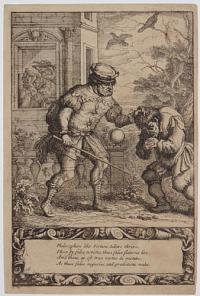
Philosophers like Fortune-tellers thrive, / Those by false notions, these false flateries live, / And those as oft true vertue do mistake, / As these false auguries, and predictions make.
[Etched by Thomas Dudley after Francis Barlow.]
[London, 1687.]
Etching. Sheet 250 x 170mm (9¾ x 6¾"). Trimmed within plate on three sides, paper toned.
Aesop being beaten by Xanthus for saying he had seen two crows, when only one was in sight. One of thirty-two illustrations to the 2nd edition of 1687 of Barlow's Aesop, showing scenes from his life. Aesop began life as a slave in Samos, owned by Xanthus.
[Ref: 40312] £160.00
(£192.00 incl.VAT)
![[Aesop welcomed on his return to Samos]](img-thumbnail/jpegs/47305.jpg)
[Aesop welcomed on his return to Samos] When Eloquence the stuborne powers assailes, / It oft beyond dull brutall force prevailes [...]
[Thomas Dudley after Francis Barlow, 1678/9]
Etching, platemark approx. 240 x 165mm (9½ x 6½").
One of thirty-two illustrations to the second (1687) edition of Francis Barlow's Aesop, showing scenes from the life of the Greek storyteller. All of the plates were designed by Barlow but only five were etched by him. The rest, including this one, were etched by Thomas Dudley (1678-9, fl.). Little is known of Dudley- he signed himself as a student of Wenceslaus Hollar in one print and while he etched some portraits, his prints after Barlow are his most important work. In 1679 he went to Lisbon, where he is known to have made further prints, and he is not supposed to have returned to England thereafter.
[Ref: 47305] £70.00
(£84.00 incl.VAT)
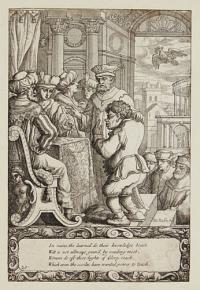
In vaine the learned do their knowledge boast, Witt is not allways gain'd, by reading most, Women do oft those hights of Glory reach, Which even the scooles, have wanted power to teach. 20.
Tho: Dudley. fec.
[n.d. c.1679.]
A very rare etching. 240 x 160mm (9½ x 6¼"). Cut and laid; tear to upper left corner.
Aesop interpreting to the Samians the portent of the eagle and the public ring; Xanthus presenting Aesop to the rulers of Samos who are seated at a table on a raised platform; in the background buildings, above which flies the eagle with the ring in its beak. Plate 20, one of thirty-two illustrations to the 2nd edition of 1687 of Barlow's Aesop, showing scenes from the life of Aesop.
[Ref: 31068] £140.00
(£168.00 incl.VAT)
![[The Satyr and the Peasant.] Iste frigus & ardorem [...]](img-thumbnail/jpegs/57441.jpg)
[The Satyr and the Peasant.] Iste frigus & ardorem [...]
J. Jordaens, pinxit. Vosterman scul:
Cum Privilegÿs Reg: [n.d., c.1621.]
Engraving. 415 x 405mm (16¼ x 15¾). Thread margins, repairs to left platemark.
A satyr chastises a peasant for blowing on his food, after he had blown on his hands to keep them warm. The satyr says ''I can no longer consider you as a friend, a fellow who with the same breath blows hot and cold". One of several paintings by Jacob Jordaens (1593-1678) based on one of Æsop's fables. According to the BM the original painting is in the Kunstmuseum in Göteborg, with another version in the Musées Royaux des Beaux-Arts, Brussels. BM 1873,1213.588.
[Ref: 57441] £320.00
(£384.00 incl.VAT)
![[The Satyr and the Peasant.]](img-thumbnail/jpegs/57789.jpg)
[The Satyr and the Peasant.]
Dutius 1764 [Etched by Christian Dietrich, after Cornelis Bega?].
Fine etching. 140 x 170mm (5½ x 6¾"). Narrow margins, mounted on album paper at corners.
A fine impression showing a satyr chastises a peasant for blowing on his food, after he had blown on his hands to keep them warm. The satyr says ''I can no longer consider you as a friend, a fellow who with the same breath blows hot and cold". Based on one of Æsop's fables. Linck 100.39.
[Ref: 57789] £360.00
(£432.00 incl.VAT)
![[A young girl with a dove.]](img-thumbnail/jpegs/47336.jpg)
[A young girl with a dove.]
[Vieira Del.t. F. Bartolozzi Sculps.t R.A. Engraver to his Majesty.]
[London, Published 1st June 1800 by William Jeffrey & Co.]
Stipple, scarce touched proof before letters, with added watercolour either by the artist or engraver. 440 x 340mm (17¼ x 13¼"), with wide large margins.
Portrait of a young girl with a garland in her hair, holding a dove, engraved by Francesco Bartolozzi after Francisco Vieira 'Portuense' (1765-1805). A later state was published as 'Affection. From an Original Drawing in the Possession of John Scott Esq.r', by Deely in 1809. Vieira came to London c.1796 and became Bartolozzi's lodger. After exhibiting at the R.A. in 1798 and 1799 he returned to Oporto, becoming court painter in Lisbon in 1802. At the same time Bartolozzi became director of the National Academy of Lisbon, living there until he died. De Vesme 1305. Provenance: Edge Hall Library, Cheshire
[Ref: 47336] £260.00
(£312.00 incl.VAT)
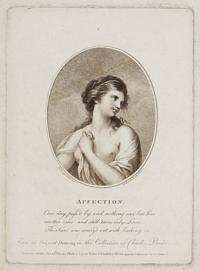
Affection. One day pass'd by and nothing saw but Love / another came and still 'twas only Love. / The Sun, was weary'd out, with looking on [...]
G.B. Cipriani inv. F. Bartolozzi sculp.
London Publish'd June 1.st 1782 by J. Walker Carver, Gilder & Printseller No. 148, opposite Catherine Street, Strand.
Stipple printed in sepia, platemark 210 x 150mm (8¼ x 6") very large margins.
An oval stipple engraving of a haf-naked woman by Francesco Bartolozzi (1725-1815) after his frequent collaborator Giovanni Battista Cipriani (1727-85). Calabi & De Vesme 571 iii/iii.
[Ref: 44205] £190.00
(£228.00 incl.VAT)
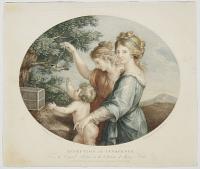
Affection and Innocence. From the Original Picture, in the Collection of George Keate, Esq.r.
F. Bartolozzi R.A. inv.r et del.t. P.W. Tomkins Sculp.t pupil of F. Bartolozzi.
London, Published Feb.y 1st 1810, by Ant.y Molteno, Printseller to her R.H. the Dutchess of York, No. 29, Pall Mall. (Bit later)
Stipple, printed in colours. 310 x 370mm. 12¼ x 14½". Laid on album paper.
Two women and a young boy playing with a tethered bird. First published by James Birchall in 1785.
[Ref: 27903] £180.00
(£216.00 incl.VAT)
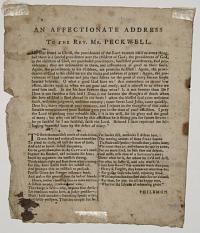
An Affectionate Address To the Rev. Mr. Peckwell. "My dear friend in Christ, the providences of the Lord extends itself to every thing, but there is a special providence over the children of God; the providences of God, to the Children of God, are purchased providences, santicified providences, soul providences;...but who can tell but by this affliction he is fitting you for future service: be ye faithful for I am faithful, faith the Lord. Beloved I have reprinted the following beautiful lines by the desire of many." To shew the matchless worth of truth divine, Grace, love and reason all in one combine...For thee, for you, for all the happy race, Who live the subjects of redeeming grace. Philemon.
[n.d. c.1780.]
Letterpress, rare. Signed to Mr. Peckwell [in ink on verso.] 190 x 165mm. 7½ x 6½". Creasing, spotting and time staining.
Reverend Henry Peckwell (1747-1787) was a divine who matriculated at St Edmund Hall, Oxford in 1770. He was of a Methodist learning and studied medicine in order to help the poor who came within his foundation The Sick Man's Friend. This is a letter from those he helped pray for his recovery from his own illness.
[Ref: 18914] £160.00
(£192.00 incl.VAT)
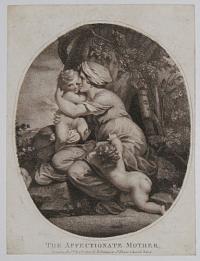
The Affectionate Mother.
[T. Kirk.]
London Pubd. Novr. 1. 1787 by T. Simpson St. Pauls Church Yard.
Stipple with etching, printed in brown ink, sheet 200 x 150mm. 8 x 6". Trimmed to plate.
A very attractive oval composition in a wooded landscape; a woman in simple dress sitting under a tree in profile, embracing a naked infant with both arms; another child at her knee pulls on her skirts. By Thomas Kirk (1765 - 1797). Ex Collection Norman Blackburn.
[Ref: 18534] £160.00
(£192.00 incl.VAT)

Philip Affleck, Esq.r Rear Admiral of the White, Commander in Chief of His Majesty's Ships at Jamaica & the Bahama Islands.
Painted by Ed.d. Penny, R.A.
Engraved by Jn.o Young, Engraver in Mezzotinto to His Royal Highness the Prince of Wales, Cockspur Street, London, 1792.
A very fine mezzotint. 350 x 500mm (13¾ x 19¾"), wide wide margins.
Philip Affleck (1726-1799), British admiral. A full-length portrait to left seated at a table. He wears a captain's uniform and a white wig and buckled shoes. His left hand is on his knee and his right rests on a chart on the table. Also on the table is a pair of dividers, a globe, a paper knife and a book. In the right background on the wall is a painting of a ship off the Cape of Good Hope. Affleck spent his early sea training in the service of the Honourable East India Company before transferring to the Royal Navy. He became a lieutenant rather late in 1755. Boscawen made him a commander during the taking of Louisbourg in 1758 and, after following the admiral to the Mediterranean, he was made a captain after the Battle of Lagos in the following year. In the War of American Independence, he commanded the 'Triumph', 74 guns, and fought at Rodney's two actions with de Guichen in 1780. After getting his flag in 1787, he went as commander-in-chief to the West Indies, 1790-93. On his return he became a Lord of the Admiralty until he retired in 1796. CS: 1 [only state].
[Ref: 4603] £390.00
![[Afghan Hounds.]](img-thumbnail/jpegs/47908.jpg)
[Afghan Hounds.]
Henry Wilkinson.
Etching signed by the artist. 230 x 340mm (9 x 13½"). Limited edition: 3/150.
An etching by artist Henry Wilkinson (1921-2011) who specialised in sporting dogs and scenes.
[Ref: 47908] £230.00
(£276.00 incl.VAT)
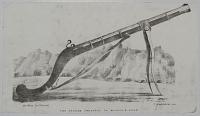
The Afghan Joozaeel or Mountain Rifle.
On Stone by J.Bennett. T. Black, Lith Cal. 1840.
Lithograph, rare. Sheet 115 x 205mm, 4½ x 8¼". Narrow margins.
A very unusual illustration of a jezail, with the distinctively curved stock and a bipod. It has been suggested that the jezail was originally designed to be held like a pistol with the stock under the arm, allowing use on horseback. However during the First Anglo-Afghan War (1839-42) it came into its own as a sniper weapon, fired down from high cliffs down onto the British Army retreating from Kabul to Jalalabad. Being heavier and longer-barrelled than the British Brown Bess musket, the Jezail outmatched the return fire. Most were hand-made: only a few were rifled.
[Ref: 27025] £65.00
(£78.00 incl.VAT)
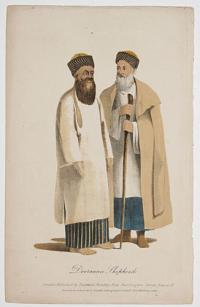
Dooraunee Shepherds.
London Published by Richard Bentley, New Burlington Street, Regent S.t. Printed in colour at A. Ducôtés Lithographic Estab.t 70, S.t Martins Lane. [n.d., c.1839.]
Hand-coloured lithograph, rare. Sheet: 225 x 145mm (9 x 5¾").
A portrait of two Afghan shepherds. An illustration from Mountstuart Elphinstone's 'An Account of the Kingdom of Caubul...'
[Ref: 47240] £65.00
(£78.00 incl.VAT)
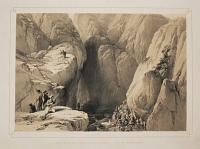
Entrance Into Kojak Pass from Parush.
[James Atkinson.]
[n.d., c.1842.]
Tinted lithograph. Sheet: 330 x 515mm (13 x 20¼'').
A view of a mountain pass through which a crowd of men and soldiers walk attented by tribesmen. Plate 9 from 'Sketches in Afghanistan' by James Atkinson, one of the earliest studies of Afghanistan.
[Ref: 50134] £260.00
(£312.00 incl.VAT)
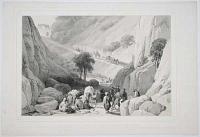
The Troops Emerging from the Narrow Part of the Defile.
[J. Atkinson.]
[London: H. Graves & Co., 1842.]
Sepia tinted lithograph heightened in white, image 250 x 365mm. 9¾ x 14¼".
Anglo-Indian troops with camels on a narrow mountain pass observed by commanding officers in the foreground. The First Anglo-Afghan War was fought between British India and Afghanistan from 1839 to 1842. From 'Sketches in Afghaunistan' by James Atkinson of the East India Company’s Bengal Medical Service. Lithography by Louis and Charles Haghe. Abbey Travel: 508, 11. British Library: 000135888.
[Ref: 20457] £250.00
(£300.00 incl.VAT)
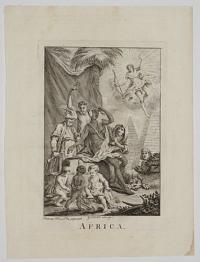
Africa. Plate 143. Vol.2. No.84. page 326.
G. Child Sculp.t
[n.d. c.1759.]
Engraving with large margins. Plate 235 x 158mm. 9¼ x 6¼".
An allegory of Africa, with various figures and two pyramids and a sphynx seen to the right. From Thomas Salmon's "The Universal Traveller: or, A Compleat Description of the several Nations of the World...", Vol.II, in which Salmon describes his travels in West Africa, particularly the Guinea coast, which was also called 'Calabar' in the 1700s. He described the African way of living, from their clothing styles and houses to the slave trade.
[Ref: 27950] £160.00
(£192.00 incl.VAT)
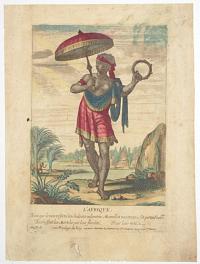
L'Afrique. Bien que de mes Deserts les chaleurs indomtees / Enchassent les Mortals par leur sterilite; / Mesvilles neantinoins sot partout habitees, / Pour leur utilite.
Bosse fe. avec Privilege du Roy
a paris chez chereau le jeaune ruë St Jacques au S.t Remy [n.d., c.1740].
Engraving with original hand colour. 215 x 140mm (8½ x 5½") very large margins. Stain in left margin. Repaired hole in bottom of lower margin.
A female allegorical figure representing Africa, dressed in colourful cloth carrying a parasole and tambourine, an elephant in background.
[Ref: 55117] £220.00
(£264.00 incl.VAT)
![[African Austale.]](img-thumbnail/jpegs/39973.jpg)
[African Austale.]
A. Biasoli inc.
[Milan: Antonio Fortunato Stella, 1816-27.]
Coloured aquatint with very large margins; publisher's stamp to lower right. Plate: 171 x 235mm, (6¾ x 9¼").
Three men: one with spear, another with a bottle in one hand and balancing wood on his head with the other; the third man sits holding a type of horn and pole. Published in Giulio Ferrario's 'Le Costume Ancien et Moderne ou Histoire du gouvernement, de la milice, de la religion, des arts, sciences et usages de tous les peuples anciens et modernes d'après les monuments de l'antiquité et accompagné de dessins analogues au sujet par le Docteur Jules Ferrario'.
[Ref: 39973] £110.00
(£132.00 incl.VAT)
![[African Austral.]](img-thumbnail/jpegs/39974.jpg)
[African Austral.] 61.
A. Biasoli inc.
[Milan: Antonio Fortunato Stella, 1816-27.]
Coloured aquatint with very large margins, publisher's stamp to lower right. Plate: 172 x 235mm, (6½ x 9¼"). Some creasing and marks.
Two African guards standing holding shields, one holds an axe and the other a spear. They both sport wicker head-pieces; ships seen on the river behind. Published in Giulio Ferrario's 'Le Costume Ancien et Moderne ou Histoire du gouvernement, de la milice, de la religion, des arts, sciences et usages de tous les peuples anciens et modernes d'après les monuments de l'antiquité et accompagné de dessins analogues au sujet par le Docteur Jules Ferrario'.
[Ref: 39974] £140.00
(£168.00 incl.VAT)
![[Two groups of African figures.]](img-thumbnail/jpegs/22653.jpg)
[Two groups of African figures.] Durands Voyage [upper left.]
[Anon.]
[London: R. Phillips, 1816.]
Etching and aquatint, two images on a single leaf, sheet 210 x 125mm. 8¼ x 5". Trimmed to plate.
In total nine figures are numbered, identified in a key below each image; they include a 'Moorish' Prince and Princess, female slaves and a Senegalese priest. A costume plate from an English edition of Jean Baptiste Léonard Durand's 'Voyage au Senegal': 'A Voyage to Senegal; or, Historical, Philosophical, and Political Memoirs, Relative to the Discoveries, Establishments, and Commerce of Europeans in the Atlantic Ocean, from Cape Blanco to the River of Sierra Leone'. Durand was a director of the commercial 'Compagnie du Sénégal'.
[Ref: 22653] £95.00
(£114.00 incl.VAT)
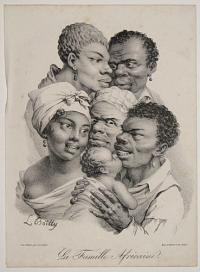
La Famille Africaine.
L. Boilly [signed in plate.]
Chez Aubert gal. vero-dodat. Imp. d'Aubert et de Junca. [Paris, 1823-1828.]
Lithograph, sheet 260 x 210mm. 11½ x 8¼".
Louis-Léopold Boilly, (1761 - 1845), He studied painting as a teenager before moving to Paris in 1785. He created images of the Parisian Salon lifestyle with great detail of expression, gesture, costuming, and textiles. His most famous printed lithographs are 'Recueil de grimâces'. A caricature of an African family (five adults and a baby), with exaggerated racial characteristics, from Louis Léopold Boilly's (1761 - 1845) 'Recueil de grimâces' series of studies of facial expression and gesture.
[Ref: 17975] £280.00
(£336.00 incl.VAT)
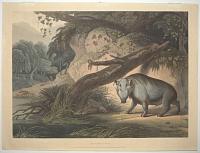
The African Hog.
Drawn, Engraved & Published by Samuel Daniell, No 9 Cleveland Street, Fitzroy Square, London, Aug.t 15, 1805.
A very rare coloured aquatint. Sheet 380 x 505mm (15 x 20"), on Whatman paper. Trimmed within plate,
A bushpig at a watering hole, a tribesman with hunting dogs behind, published in Daniell's 'African Scenery and Animals', one of the scarcest plate books on South Africa. Despite the inscription it had been suggesed that the plates were in fact engraved by William Daniell. Daniell (1775-1811) arrived in South Africa in 1799 (soon after British occupation) and in 1801 joined an exploratory expedition to Bechuana, then at the limit of known territory. Daniell himself discovered the Kuruman Eye, a drinkable spring rising up into the Kalahari Desert, which has become one of South Africa's most celebrated natural wonders. He lived in Ceylon from 1806 until his death from tropical fever. Abbey: 321.
[Ref: 52840] £550.00
![[South African Mongoose.] Cynictis Steedmannii.](img-thumbnail/jpegs/44728.jpg)
[South African Mongoose.] Cynictis Steedmannii. Trans. Zool. Soc. Vol. 1. Pl.3 pp.34.
E. Lear, del. Zeitter sc.
[n.d., c.1835.]
Hand-coloured etching. Sheet: 310 x 245mm (12 x 9¾"). Trimmed within plate on top and bottom edges.
A diagram of a South African Mongoose, named after Andrew Steedman who travelled through South Africa collecting specimens for study. After a drawing by the artist Edward Lear (1812-1888). An illustration for 'Transactions of the Zoological Society of London, Vol 1'.
[Ref: 44728] £95.00
(£114.00 incl.VAT)
![[Scrap album sheet of photographs and sketches made in Yemen, Mauritius, South Africa and the Seychelles]](img-thumbnail/jpegs/43208.jpg)
[Scrap album sheet of photographs and sketches made in Yemen, Mauritius, South Africa and the Seychelles]
[Anon., c.1890]
Album sheet, 355 x 245mm (13¾ x 9½"), with three photographs and five sketches attached.
Album sheet comprising three photographs labelled: 'Port Louis' (Mauritius); 'The gardens, Pamplemouse, Mauritius'; 'The tanks Aden' (Yemen); and five sketches: 'The Port Bourbon' (Mauritius); 'Seychelles Islands'; 'East London South Africa'; 'From the Crater Cure Pipe Mauritius'; and 'Tamatave' (Toamasina, Madagascar).
[Ref: 43208] £180.00
(£216.00 incl.VAT)
view all images for this item
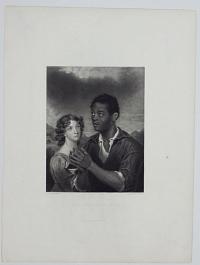
The African Prince.
Painted by H. Meyer. Engraved by R. Hicks.
Fisher, Son & Co. London, 1844.
Engraving. Plate: 230 x 145mm (9 x 5¾'').
A scene showing a young African prince embracing a young woman, holding a book.
[Ref: 49953] £65.00
(£78.00 incl.VAT)
![[Frontispiece.]](img-thumbnail/jpegs/48102.jpg)
[Frontispiece.] To David Davies Esq.r this Second Part of African Scenery and Animals is Most Respectfuly Inscribed from a Grateful Recollection of his Long and Valuable Friendship by his much Obliged and Faithful Humble Servant Samuel Daniell.
[n.d., c.1806.]
Aquatint, fine, watermark 1801 J. Whatman. Plate: 380 x 500mm (15 x 19¾'') very large margins.
A frontispiece to Samuel Daniell's 'African Scenery and Animals' which described the animals and and landscape of South Africa.
[Ref: 48102] £320.00
![[Frontispiece.]](img-thumbnail/jpegs/48103.jpg)
[Frontispiece.] To Lieutenant General Francis Dundas Late Lieut and Acting Governor of the Cape of Good Hope under whose Patronage the Materials of the Present Work were Collected this First Part of African Scenery and Animals is inscribed with the Greatest Respect by his Most Obliged and Faithful Humble Servant Samuel Daniell.
[n.d., c.1806.]
Aquatint. Plate: 380 x 500mm (15 x 19¾''). Foxing and handling marks
A frontispiece to Samuel Daniell's 'African Scenery and Animals' which described the animals and and landscape of South Africa.
[Ref: 48103] £240.00
(£288.00 incl.VAT)

The Generous Master or African Sincerity. a West-India anecdote.
Argus del.t.
London Pub Jan.y 9 1819 by S.W. Fores 50 Piccadilly & 312 Oxford Street.
Etching with hand-colouring, sheet 350 x 245mm (13¾ x 9½"). Trimmed inside platemark and glued to backing sheet; staining and paper tone.
An invalid tells his black servant 'Pompey' that he has made provision in his will for Pompey to be buried beside him in the same tomb. Pompey, however, is horrified at the idea, and worries that because of the darkness in the tomb, the devil might mistakenly take him instead of his master. A rare and interesting image. BM Satires 13193.
[Ref: 41468] £260.00
(£312.00 incl.VAT)


![[Life of Aesop: Aesop convicting his fellow servants of having eaten the figs.]](img-thumbnail/jpegs/48708.jpg)
![[Life of Aesop: Aesop resolving the gardener's problem.]](img-thumbnail/jpegs/48712.jpg)
![[Life of Aesop: Aesop ordered by Xanthus to take a dish to her that loves him best.]](img-thumbnail/jpegs/48699.jpg)
![[Life of Aesop: Aesop serving tongues.]](img-thumbnail/jpegs/48715.jpg)
![[Life of Aesop: Aesop taken to prison.]](img-thumbnail/jpegs/48710.jpg)
![[Life of Aesop: Beaten by Xanthus.] [Philosophers like Fortune-tellers thrive,](img-thumbnail/jpegs/48698.jpg)
![[Life of Aesop: Aesop interpreting an inscription on a tomb, thereby discovering a treasure.]](img-thumbnail/jpegs/48704.jpg)
![[Life of Aesop: Aesop interpreting to the Samians the portent of the eagle and the public ring.]](img-thumbnail/jpegs/48709.jpg)
![[Life of Aesop: Aesop kneeling before king Croesus.]](img-thumbnail/jpegs/48714.jpg)
![[Life of Aesop: Aesop welcomed on his return to Samos from the court of Lydia.]](img-thumbnail/jpegs/48707.jpg)
![[Life of Aesop: Aesop falsely accused by Eunus, his adopted son.]](img-thumbnail/jpegs/48713.jpg)
![[Life of Aesop: Aesop in the sepulchre fed by Hermippus.]](img-thumbnail/jpegs/48701.jpg)
![[Life of Aesop: Eunus confronted by Aesop.]](img-thumbnail/jpegs/48700.jpg)
![[Life of Aesop: Aesop with King Nectenabo, king of Egypt.]](img-thumbnail/jpegs/48711.jpg)
![[Life of Aesop: the death of Aesop.]](img-thumbnail/jpegs/48706.jpg)
![[Life of Aesop: Aesop bought by the philosopher Xanthus.]](img-thumbnail/jpegs/48702.jpg)
![[Life of Aesop: Aesop passing the house of the father of Xanthus's wife.]](img-thumbnail/jpegs/48703.jpg)
![[A music teacher and lady in an interior.]](img-thumbnail/jpegs/27042.jpg)
![[Titlepage] Æsop at Court; or, The labyrinth of Versailles Delineated in French and English. The Plates Engraved by G. Bickham. From the Paris Edition.](img-thumbnail/jpegs/26900.jpg)

![[Aesop welcomed on his return to Samos]](img-thumbnail/jpegs/47305.jpg)

![[The Satyr and the Peasant.] Iste frigus & ardorem [...]](img-thumbnail/jpegs/57441.jpg)
![[The Satyr and the Peasant.]](img-thumbnail/jpegs/57789.jpg)
![[A young girl with a dove.]](img-thumbnail/jpegs/47336.jpg)





![[Afghan Hounds.]](img-thumbnail/jpegs/47908.jpg)






![[African Austale.]](img-thumbnail/jpegs/39973.jpg)
![[African Austral.]](img-thumbnail/jpegs/39974.jpg)
![[Two groups of African figures.]](img-thumbnail/jpegs/22653.jpg)


![[South African Mongoose.] Cynictis Steedmannii.](img-thumbnail/jpegs/44728.jpg)
![[Scrap album sheet of photographs and sketches made in Yemen, Mauritius, South Africa and the Seychelles]](img-thumbnail/jpegs/43208.jpg)

![[Frontispiece.]](img-thumbnail/jpegs/48102.jpg)
![[Frontispiece.]](img-thumbnail/jpegs/48103.jpg)
